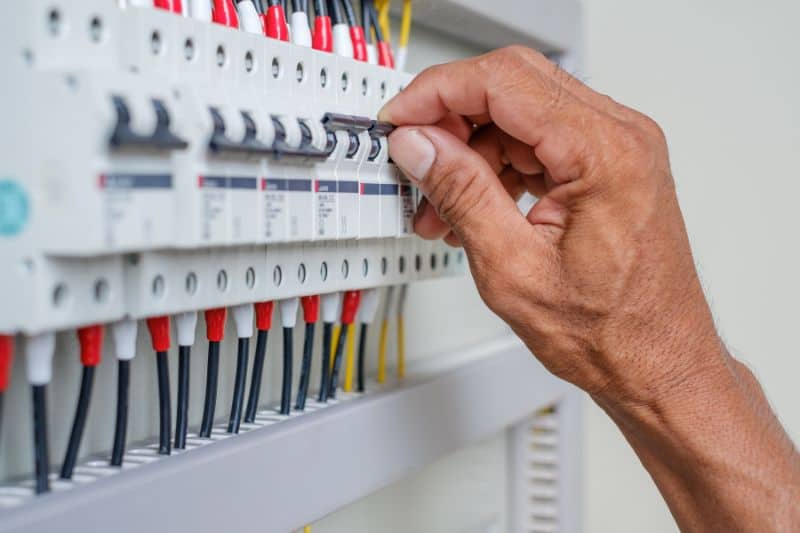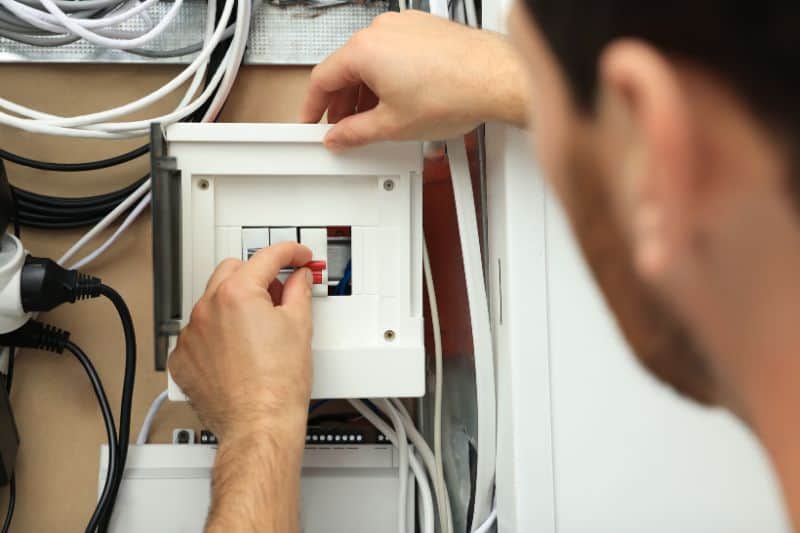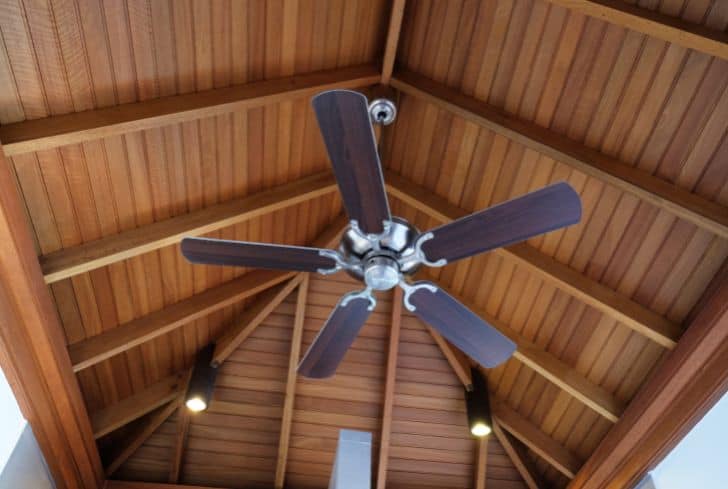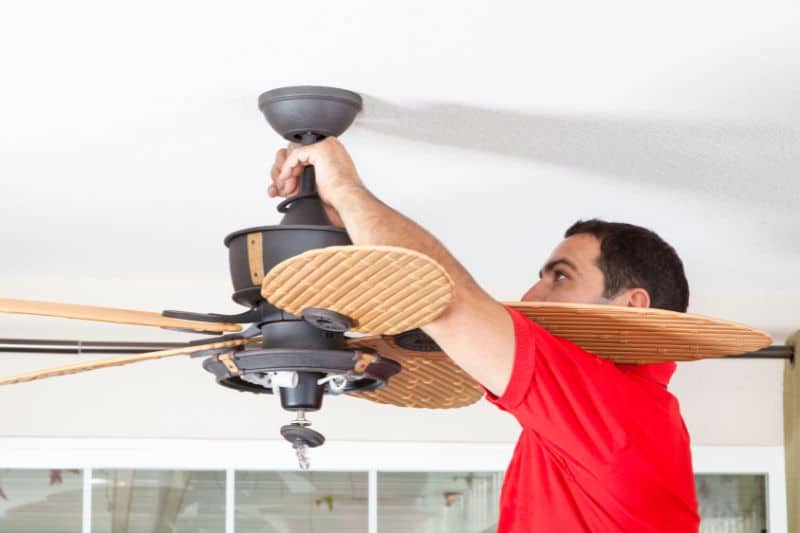So, you want to install a ceiling fan. Or maybe you are confused as to how you rack up your monthly or yearly electricity bills and would like an estimate and breakdown. The size of your ceiling fan is the primary determinant of how many amps it will consume, among other factors, such as speed.
The electricity consumption also varies from one brand to another. This article will provide an overview of what to expect from each size, although the average cooling fan requires less than an amp.
How Many Amps Does a Ceiling Fan Draw?
A Ceiling fan draws less than an amp of energy for each hour of use. The energy the appliance will consume depends on the size and the setting it runs on, but even the largest fans running at the highest speed shouldn’t require more than 0.85 amps when connected to a standard 120-volt circuit. It can be lower; set it to a low rate, and you can use as little as 0.17 amps.
There are many cooling options in the market today. But if you are conscious about your power usage, you will naturally wonder which is best for you.
An air conditioner requires more energy, consuming between 15 to 60 amps. On the other hand, a ceiling fan requires less, even though you cannot compare both devices’ functions and cooling capabilities.
A ceiling fan will come in handy in temperatures where you don’t need too much cool air. Although it isn’t as effective as an air conditioning unit, you can still use a ceiling fan in cooler times, like the early days of summer.
At most, it draws an average of 0.5 to 1 amp. The voltage determines how high the number goes, as well as the speed and size.
For instance, a large ceiling fan will consume a higher voltage and higher number of amps for each hour of use, while a smaller one will stick within two decimals and less than 0.5 amps.

How Many Ceiling Fans Can Be on a 15 amp Circuit?
It depends on each ceiling fan’s electrical consumption per unit and hour. But let’s dedicate 1.5 amps to each ceiling fan since the larger and most optimized versions will not consume more than 1 amp of electrical current for each hour. On a 15 amp circuit, you can connect between eight to ten ceiling fans.
Dedicate 1.5 amps to each one to ensure no electrical starvation from any angle. This is also to ensure a short circuit does not affect the performance of your device.
Since the average ceiling fan consumes between 0.5 to 1 amp of electrical currents, a 15-amp circuit will host eight of these gadgets to ensure plenty of protection, but you can still work with up to 10 without any problems, especially if you have the standard models.
However, if you have some of the industry’s “big boys”, avoid going above eight ceiling fans to allow room for the additional power surge that may happen now and then.
How Much Electricity Does a Ceiling Fan Use in 24 Hours?
You can calculate the amount of electricity your ceiling fan uses in twenty-four hours, but you need several details. These include the number of hours you run it daily, assuming you don’t use the fan all day. You also need to know the number of watts it consumes for each hour, the wattage, and the price you pay for each unit of energy.
The standard 48-inch ceiling fan consumes a low amount of energy. You can expect a tiny average of 75 watts each hour.
In most cases, the wattage is stated by the manufacturer or on the product, but it simply means the rate of energy consumption on an hourly basis. That’s to say, when a fan is a 75-watt model, for instance, it uses 75 watts per hour.
Your electricity consumption will be ultimately determined by multiplying the number of wattage by the number of hours of use. That will give you the kilowatt rating; let’s do that now.
The formula for deriving kWh:
kWh = (Ceiling Fan Wattage x Duration of Use (hrs)) / 1,000
Estimated Cost = kWh * Average kWh rate in the US
The size of the ceiling fan determines how much energy it will consume. You will often find a ceiling fan between the range of 42 to 55 inches, with an average wattage consumption of 55 to 100 watts on each amp it uses.
Let’s assume the ceiling fan uses 75 watts and runs for an average of eight hours per day.
At 75 watts per hour and for eight hours daily, multiply it by the number of hours and divide by 1000 to gauge the kWh rating. That is, seventy-five watts x eight hours daily, divided by 1000, results in 0.6 kWh.
Electricity consumption is calculated by multiplying your kWh consumption by your country’s electricity cost.
Daily electricity consumption for a ceiling fan of 75 watts = 0.6 kWh when used for eight hours. Assuming the average kWh rate in the US at 15 cents per hour, you will spend a total of $0.09 daily.
That is;
1 kWh = $0.15
0.6 kWh = ?
(0.6kWh x $0.15)/1 kWh
= $0.09
How Many Amps Does a 52, 56, 60, 70 Inch Ceiling Fan Pull?
The ampere consumption of each device varies and depends on the size and functionality. 52, 56, 60, and 70 are pretty common in the household, so let’s examine their electricity consumption one after the other.
A 52-inch ceiling fan consumes about 84 watts per hour, translating to 0.7 amps of electricity assuming it’s connected to a 120-volt circuit. Fifty-two inches is a good size for the bedroom, living room, or small garage. If you decide to install this appliance in any of these areas, you will not use up too much electricity monthly because it does not draw a high amperage.
A 56-inch will also do well in your living room, bedroom, or garage. It consumes about 90 watts per hour, translating to 0.75 amps for each hour of use, again when connected to a 120-volt circuit. Again, this is a reasonable amount to consume, and you will not rack up an exorbitant bill at the end of the month.
Are you also curious about a 60-inch fan’s energy consumption? It pulls 0.8 amps, for each hour you use it, and that’s because the wattage ranges in the area of 96. Meanwhile, a 120-inch fan has a wattage of about 120 watts, meaning the amperage is 1, again connected to a 120-volt circuit.
Does a Ceiling Fan Need Its Own Circuit?
Barely! A ceiling fan consumes meager electricity, which means it will not immobilize the breaker. However, you can also give your ceiling fan its dedicated circuit, but there is a condition. As with everything, moderation is key. If a ceiling fan is exposed to a dedicated circuit with excessive ampere coverage, it has a high chance of overheating.
Ceiling fans do not need their own circuit. They don’t consume too much energy, so you can pair them with other devices. It does not matter whether it is a washing machine or a TV. Just ensure that the total electric load is at most 80% of the capacity of the breaker to ensure safe operations for every appliance connected.

What Size Circuit Breaker Do I Need for a Ceiling Fan?
The size of the circuit breaker needed for a ceiling fan depends on the electrical specifications provided by the fan’s manufacturer. Typically, ceiling fans require a 15-amp circuit breaker. It’s important to follow the manufacturer’s guidelines and recommendations for the specific model you have.
When installing or replacing a circuit breaker for a ceiling fan, you should ensure that the breaker’s amperage rating matches the electrical requirements of the fan.
If you are uncertain or if the information is not readily available, consult the fan’s manual or contact the manufacturer for guidance. Choosing the correct size circuit breaker is essential for the safety and proper functioning of the ceiling fan and the electrical system in your home.

Can I Install a Ceiling Fan on a 20 amp Circuit?
Yes, you can install a ceiling fan on a 20-amp circuit. In residential electrical systems, 15-amp and 20-amp circuits are standard, and both are suitable for powering ceiling fans. The key is to match the circuit breaker’s amperage rating with the electrical requirements of the ceiling fan.
Most ceiling fans have a power consumption well below the capacity of a 20-amp circuit, typically ranging from 0.5 to 1 amp. Therefore, a 20-amp circuit provides more than enough capacity to safely operate a ceiling fan.
When installing or replacing a ceiling fan, always follow the manufacturer’s guidelines and recommendations regarding electrical specifications. Additionally, ensure compliance with local electrical codes to ensure the safety and proper functioning of the fan.
Does the Ceiling Fan Consume Less Electricity at a Slow Speed?
Yes, the ceiling fan consumes less electricity at a slow speed. In fact, when running slowly, the appliance may consume 0.25 amperes or even less depending on its size and how low you set the speed. Increase the pace, and the electrical current consumption climbs with the speed increment. At the highest speed, your device will consume the number of watts indicated, which most of the time won’t exceed 100 watts, an equivalent of 0.8 amps.
This is the benchmark for smaller ceiling fans, but even the larger ones will consume something within this ballpark.
A ceiling fan does not consume too many electrical currents hourly on a typical day. It is an affordable cooling option. But when you set it to a lower speed, the energy consumption becomes even lower.
Conclusion
If you cannot decide on the type of cooling system to install in your home, know that a ceiling fan is one of the lowest consumers of energy in comparison with most other appliances in the house. You will spend less than $6 if you use it for an average of eight hours daily for an entire year!






